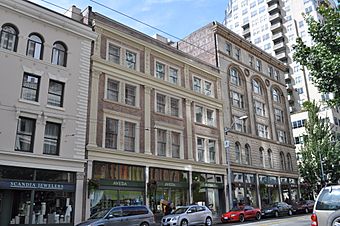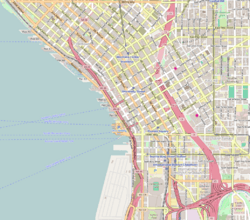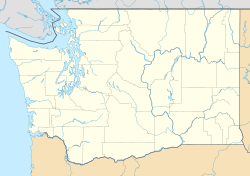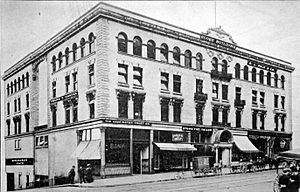Globe Building, Beebe Building and Hotel Cecil facts for kids
|
Globe Building & Beebe Building
|
|
 |
|
| Location | 1001–1031 1st Ave., Seattle, Washington |
|---|---|
| Built | 1900–1901 |
| Architect | Umbrecht, Max |
| Architectural style | Italian Renaissance Revival |
| NRHP reference No. | 82004235 |
Quick facts for kids Significant dates |
|
| Added to NRHP | April 29, 1982 |
The Globe Building, Beebe Building, and the Hotel Cecil are three historic buildings in downtown Seattle, Washington. They stand together on the west side of 1st Avenue, between Madison and Spring Streets. These buildings were constructed between late 1900 and 1901. They were built for investors from Syracuse, New York, Clifford Beebe and William Nottingham.
The Clise Investment Company, led by James Clise (1855–1938), managed the construction. James Clise was a very important person in Seattle's history. He helped shape the city in many ways. For example, he helped get the Smith Tower built. He also helped secure land for Fort Lawton and played a big part in the Denny Regrade. This project changed the city's landscape a lot. He also helped find the site for the University of Washington campus and the Lake Washington Ship Canal.
All three buildings were designed by Max Umbrecht (1872–1955). He was an architect who mostly designed homes. He came to Seattle around 1900 from Syracuse. The buildings were designed in the Italian Renaissance Style. The two northern buildings were sometimes called the Beebe buildings. They were built for Clifford D. Beebe. The Globe Building was built for William Nottingham's Globe Navigation Company.
These buildings are special because they are the last group of buildings from the 1900s still standing together on 1st Avenue. They are located between the Pioneer Square district and the Pike Place Market. After being carefully restored in 1982, they were added to the National Register of Historic Places. In 1983, they were also named Seattle City Landmarks.
Since September 10, 1982, these buildings have been known as the Alexis Hotel. As of 2016, the hotel is owned by Kimpton Hotels & Restaurants.
Building History
Early Days of the Site
Before the Great Seattle fire in 1889, the area where these buildings now stand was mostly water. Many small buildings were built on wooden poles over the water. By 1884, the biggest building was a two-story wooden structure. It was at the corner of 1st and Madison. There were also small shops and a house nearby. An interesting feature was a ramp on Madison Street. It was used to roll fire engines to collect water for fighting fires. By 1888, the block was full of warehouses and small factories.
After the big fire, not much was built on this block for a while. This was because of a tough economic time called the Panic of 1893. Maps from 1893 show only one brick building on the site. It was built right after the fire. However, Seattle's economy improved when gold was found in the Yukon in 1897. This event was called the Klondike Gold Rush. Seattle became a main supply point for gold prospectors. This led to a big building boom in the city.
Hotel Cecil and Beebe Building
The 6-story Hotel Cecil and 4-story Beebe Buildings were built by the Clise Investment Company. They were built for Clifford D. Beebe, a wealthy man from Syracuse, New York. Construction started in late 1900 and finished by late 1901. The 6-story building cost $100,000. The 4-story building cost $65,000.
The first businesses in these buildings were on the ground and second floors. Z.C. Miles & Piper Company, a home furnishing store, was one of them. The upper floors of the buildings were connected to work as a hotel. It was first called the Hotel Waldorf. Soon after opening, it was renamed the Hotel Cecil. This name came from the famous Hotel Cecil in London.
In 1909, the owners hired architect Max Umbrecht again. He was asked to completely remodel the inside of both buildings. The plan was to make the hotel very modern. The lobby and offices were completely rearranged. New features were added, and the walls were decorated with marble and frescoes.
After some time, the hotel was renamed the McFarland Hotel. Then, in 1921, it got new owners and reopened as the New Arlington Hotel. It was named after another hotel nearby. The New Arlington Hotel was popular with business travelers. It had 200 rooms, each with a telephone and hot and cold running water.
Globe Building
The Globe Building was built in 1901 by James Clise. It was for William Nottingham, another investor from Syracuse. Nottingham had a big interest in Clise's new shipbuilding company, the Globe Navigation Company. The building replaced an older, single-story brick building.
The upper floors of the Globe Building had 38 offices. The Globe Navigation Company and Clise Investment Company had offices there. Other early tenants included the Pacific Packing and Navigation Company and the Seattle News-Letter office. Architect Max Umbrecht also moved his office into the building. He was later joined by John Graham, who became a very famous architect in Seattle. James Clise also opened the Washington Trust Company on the first floor. This company later became part of Seafirst Bank.
The Globe Building was the main office for James Clise's businesses until 1917. That year, he built a much larger building called the Securities Building. He moved all his company's offices there. After he left, the types of businesses in the Globe Building changed. Pawn shops, restaurants, and a public market opened on the lower floors.




